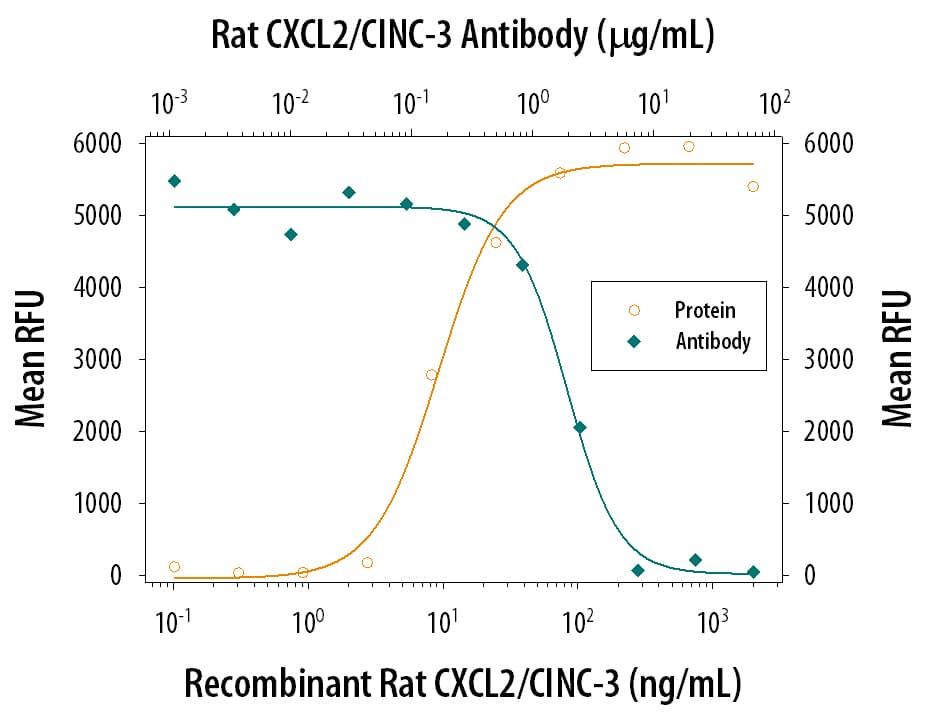Rat CXCL2/GRO beta/MIP-2/CINC-3 Antibody
R&D Systems, part of Bio-Techne | Catalog # AF525


Key Product Details
Species Reactivity
Validated:
Cited:
Applications
Validated:
Cited:
Label
Antibody Source
Product Specifications
Immunogen
Ser32-Asn100
Accession # P30348
Specificity
Clonality
Host
Isotype
Endotoxin Level
Scientific Data Images for Rat CXCL2/GRO beta/MIP-2/CINC-3 Antibody
Chemotaxis Induced by CXCL2/CINC-3 and Neutralization by Rat CXCL2/CINC-3 Antibody.
Recombinant Rat CXCL2/CINC-3 (Catalog # 525-C3) chemoattracts the BaF3 mouse pro-B cell line transfected with human CXCR2 in a dose-dependent manner (orange line). The amount of cells that migrated through to the lower chemotaxis chamber was measured by Resazurin (Catalog # AR002). Chemotaxis elicited by Recombinant Rat CXCL2/CINC-3 (0.1 µg/mL) is neutralized (green line) by increasing concentrations of Rat CXCL2/CINC-3 Antigen Affinity-purified Polyclonal Antibody (Catalog # AF525). The ND50 is typically 0.5-2.5 µg/mL.Applications for Rat CXCL2/GRO beta/MIP-2/CINC-3 Antibody
Western Blot
Sample: Recombinant Rat CXCL2/GRO beta/MIP-2/CINC-3 (Catalog # 525-C3)
Neutralization
Formulation, Preparation, and Storage
Purification
Reconstitution
Formulation
Shipping
Stability & Storage
- 12 months from date of receipt, -20 to -70 °C as supplied.
- 1 month, 2 to 8 °C under sterile conditions after reconstitution.
- 6 months, -20 to -70 °C under sterile conditions after reconstitution.
Background: CXCL2/GRO beta/MIP-2/CINC-3
Cytokine-induced neutrophil chemoattractant 3 (CINC-3) has been found to be expressed by cytokine-stimulated rat alveolar macrophages and fibroblasts. Based on its protein and DNA sequences, CINC-3 (also known as rat MIP-2, GRO beta and CXCL2) is a member of the alpha (CXC) subfamily of chemokines.
CINC-3 cDNA encodes a 100 amino acid (aa) residue precursor protein with a 31 aa signal peptide that is cleaved to yield a 69 aa mature secreted protein. The protein sequence of rat CINC-3 shares approximately 88% identity with murine MIP-2. Characteristic of ELR containing CXC chemokines, CINC-3 is known to be a potent chemotactic factor for rat neutrophils in vitro and in vivo. On the basis of cross-desensitization results of the various CINC proteins, it has been postulated that rat neutrophils have at least two classes of CINC receptors: a class of CINC-3 specific receptors as well as a second common receptor shared by all CINCs.
References
- Nakagawa, H. et al. (1994) Biochem. J. 301:545.
- Huang, S. et al. (1992) Am. J. Pathol. 141:981.
Alternate Names
Gene Symbol
UniProt
Additional CXCL2/GRO beta/MIP-2/CINC-3 Products
Product Documents for Rat CXCL2/GRO beta/MIP-2/CINC-3 Antibody
Product Specific Notices for Rat CXCL2/GRO beta/MIP-2/CINC-3 Antibody
For research use only